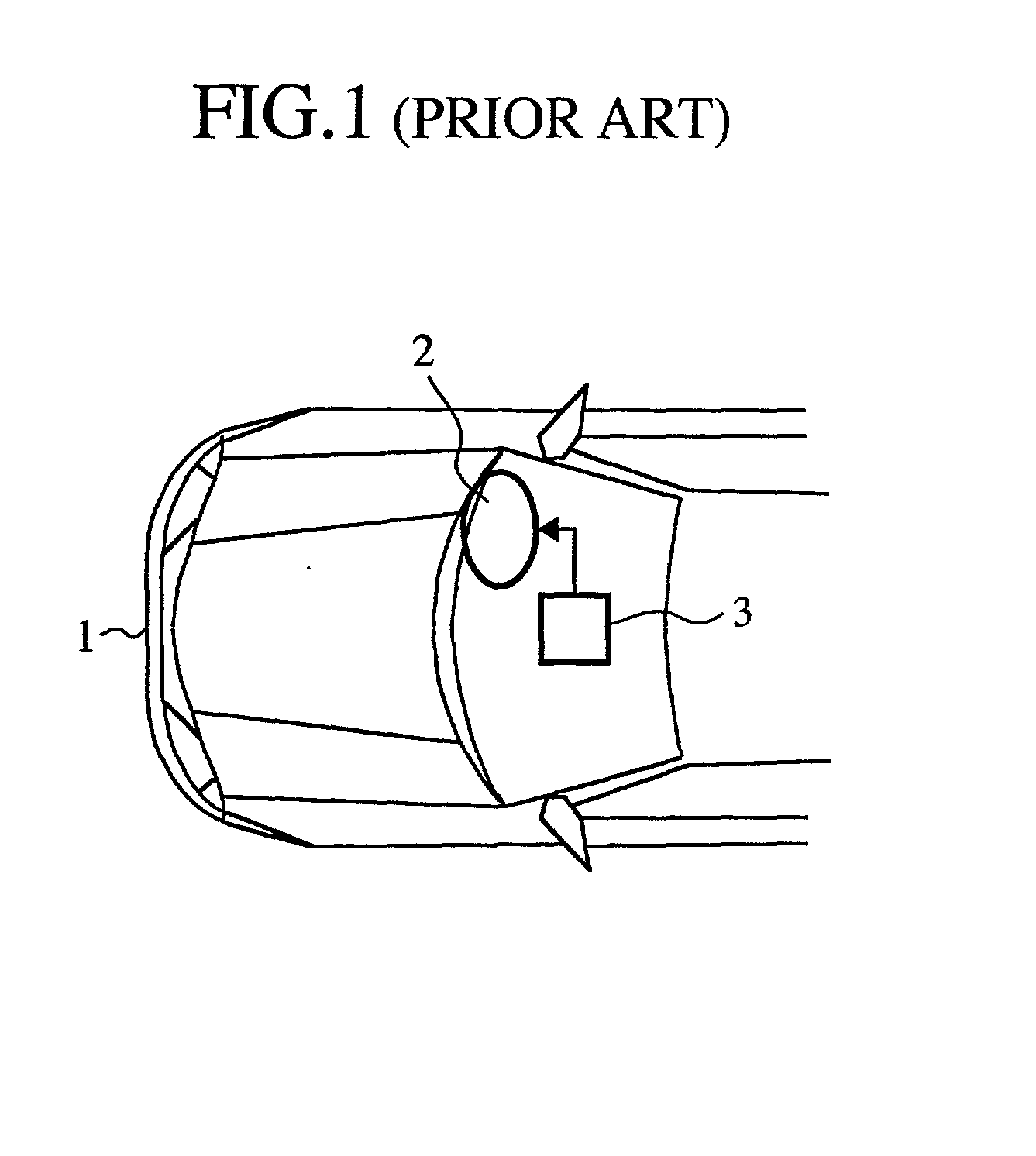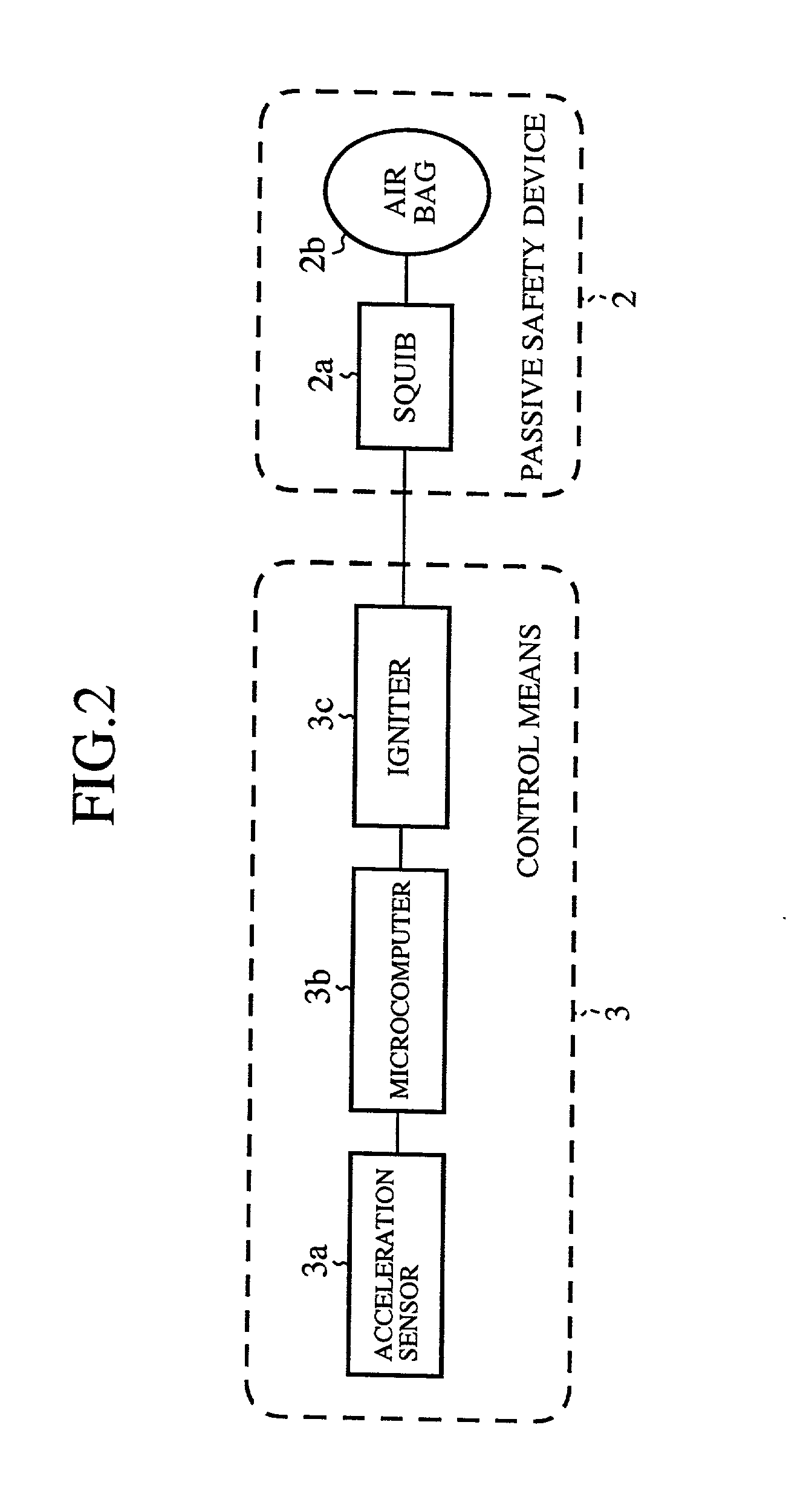Passive safety system
a safety system and passive technology, applied in the direction of pedestrian/occupant safety arrangement, instruments, tractors, etc., can solve the problem of difficult calculation of precise integrated value, and achieve the effect of preventing the integral of acceleration and shortening the reset time of integrated acceleration valu
- Summary
- Abstract
- Description
- Claims
- Application Information
AI Technical Summary
Benefits of technology
Problems solved by technology
Method used
Image
Examples
embodiment 1
[0042] Embodiment 1
[0043] FIG. 2 is a general block diagram showing a passive safety system as embodiment 1 according to the present invention. Components of the embodiment 1 common to the conventional components shown in FIG. 1 are denoted by the same reference numerals and further description will be omitted.
[0044] In FIG. 2, a reference numeral 2 denotes a passive safety device mounted on the vehicle 1 (see FIG. 1). The passive safety device 2 includes a squib (initiation device) 2a and an airbag 2b expanded by the squib 2a. A reference numeral 3 denotes a control means controlling the passive safety device 2. The control means 2 includes an acceleration sensor 3a for detecting impact acceleration caused at the time of front-collision of the vehicle 1, a microcomputer 3b inputted the acceleration detection signal from the acceleration sensor 3a as a digital data due to an A / D converter, and an igniter 3c receiving an output signal from the microcomputer 3b to supply an ignition c...
embodiment 2
[0068] Embodiment 2
[0069] FIG. 7 is a plane view showing a front section of a vehicle providing with a passive safety system as embodiment 2 according to the present invention, and FIG. 8 is a block diagram showing the passive safety system of FIG. 7. Components of the embodiment 2 common to the components shown in FIG. 1 and FIG. 2 are denoted by the same reference numerals and further description will be omitted.
[0070] In FIG. 7, a reference numeral 1 denotes a vehicle, and a reference numeral 2 denotes a passive safety device for front-collision mounted on the vehicle 1. A reference numeral 4 denotes a passive safety device for rear-collision mounted on the vehicle 1. A reference numeral 3 denotes a common control means for driving both of the passive safety devices 3 and 4. As shown in FIG. 8, the control means 3 includes an acceleration sensor 3a for detecting impact acceleration caused at the time of front-collision of the vehicle 1, a microcomputer 3b inputted the acceleratio...
embodiment 3
[0084] Embodiment 3
[0085] FIG. 11 is a plane view showing a front section of a vehicle providing with a passive safety system as embodiment 3 according to the present invention, and FIG. 12 is a block diagram showing the passive safety system of FIG. 11. Components of the embodiment 3 common to the components shown in FIG. 2 to FIG. 10 and FIG. 1 are denoted by the same reference numerals and further description will be omitted.
[0086] In FIG. 11, a reference numeral 5 denotes a right-collision passive safety device mounted on the vehicle 1, and similarly a reference numeral 6 denotes a left-collision passive safety device mounted on the vehicle 1.
[0087] In FIG. 12, a reference numeral 3f denotes a right-collision igniter, and a reference numeral 3g denotes a left-collision igniter. These igniters 3f and 3g receive output signals from the microcomputer 3b to drive the right-collision passive safety device 5 and the left-collision passive safety device 6, respectively. Here, side-coll...
PUM
 Login to View More
Login to View More Abstract
Description
Claims
Application Information
 Login to View More
Login to View More - R&D
- Intellectual Property
- Life Sciences
- Materials
- Tech Scout
- Unparalleled Data Quality
- Higher Quality Content
- 60% Fewer Hallucinations
Browse by: Latest US Patents, China's latest patents, Technical Efficacy Thesaurus, Application Domain, Technology Topic, Popular Technical Reports.
© 2025 PatSnap. All rights reserved.Legal|Privacy policy|Modern Slavery Act Transparency Statement|Sitemap|About US| Contact US: help@patsnap.com



